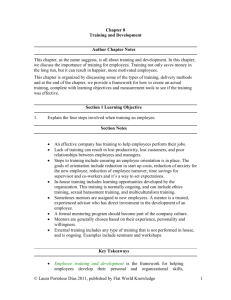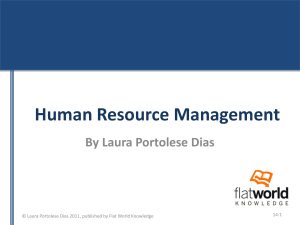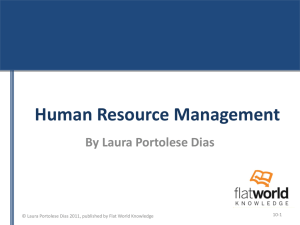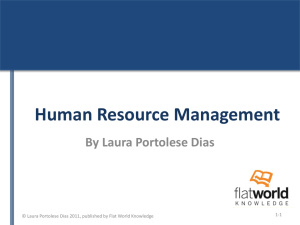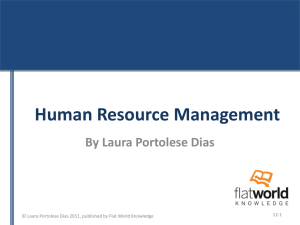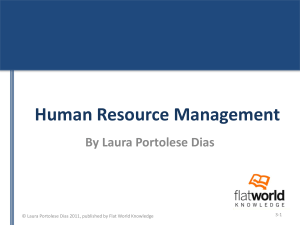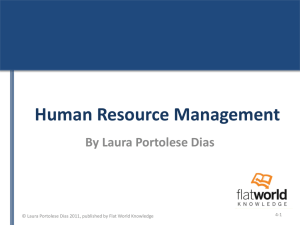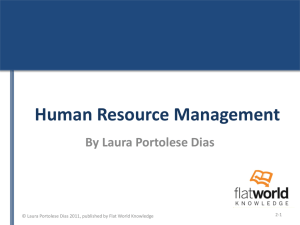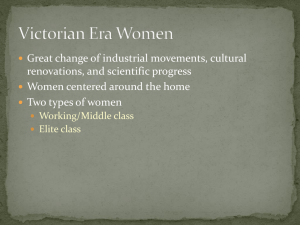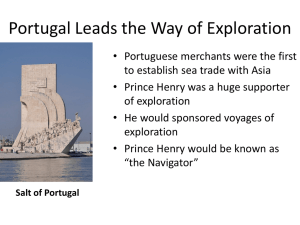Human Resource Management
advertisement
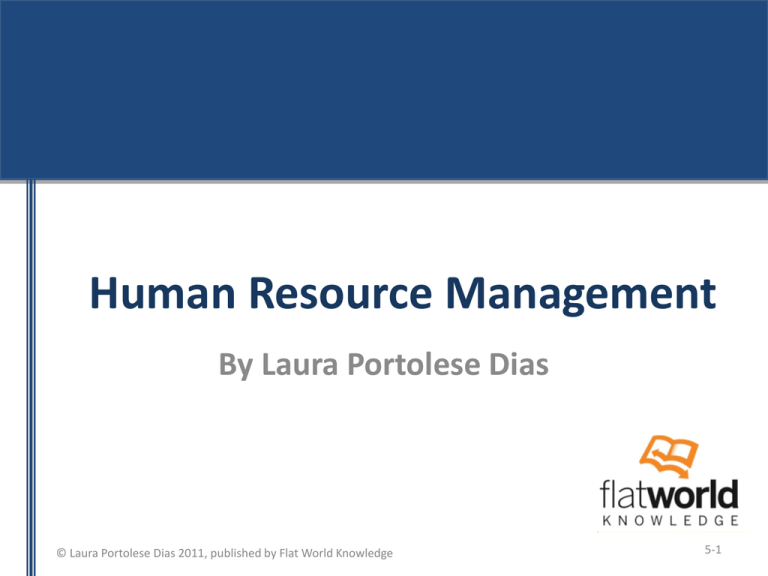
Human Resource Management By Laura Portolese Dias © Laura Portolese Dias 2011, published by Flat World Knowledge 5-1 This work is licensed under the Creative Commons Attribution-Noncommercial-Share Alike 3.0 Unported License. To view a copy of this license, visit http://creativecommons.org/licenses/by-ncsa/3.0/or send a letter to Creative Commons, 171 Second Street, Suite 300, San Francisco, California, 94105, USA © Laura Portolese Dias 2011, published by Flat World Knowledge 5-2 Chapter 5 Selection © Laura Portolese Dias 2011, published by Flat World Knowledge 5-3 Learning Objective 1. Be able to name and discuss the steps in the selection process. © Laura Portolese Dias 2011, published by Flat World Knowledge 5-4 The Selection Process • Selection process – The steps involved in choosing people who have the right qualifications to fill a current or future job opening • The role of HR – Define the process – Guide the process © Laura Portolese Dias 2011, published by Flat World Knowledge 5-5 The Selection Process • Cost of Selection Process – Statistics vary but • $40,000 (US Dept. of Labor) – Cost includes time and money spent © Laura Portolese Dias 2011, published by Flat World Knowledge 5-6 The Selection Process • 5 Steps of the Selection Process – Criteria development – Application and resume review – Interviewing – Test administration – Making the offer © Laura Portolese Dias 2011, published by Flat World Knowledge 5-7 Learning Objectives 1. Be able to explain why criteria development is an important part of the selection process. 2. Give examples of types of criteria that can be developed. 3. Describe the advantages and disadvantages of internal and external candidates. © Laura Portolese Dias 2011, published by Flat World Knowledge 1-8 Criteria Development and Resume Review • Criteria for hiring – Part of job analysis – May include other necessary skills • Development of interview questions © Laura Portolese Dias 2011, published by Flat World Knowledge 5-9 Criteria Development and Resume Review • Example of criteria might include: – Two years of experience managing a $2 million or more project budget – A bachelor’s degree in business or closely related field – Ability to work on multiple projects at once – Problem-solving ability – Conflict-management ability – Ability to manage a team of five to six diverse workers – Score of at least a 70 on cognitive ability test – Score of excellent from most recent employer © Laura Portolese Dias 2011, published by Flat World Knowledge 5-10 Criteria Development and Resume Review • Validity – How useful the tool is to measure a person’s attributes • Reliability – The degree to which other selection techniques yield similar data over time © Laura Portolese Dias 2011, published by Flat World Knowledge 5-11 Criteria Development and Resume Review • Fit issues – Looking for specific education and expertise – Also looking for fit with the company culture • Reviewing resumes – Rating system © Laura Portolese Dias 2011, published by Flat World Knowledge 5-12 Criteria Development and Resume Review • Internal and External Candidates – Advantages – Disadvantages © Laura Portolese Dias 2011, published by Flat World Knowledge 5-13 Learning Objectives 1. Explain the various types of interviews and interview questions. 2. Discuss interview methods and potential mistakes in interviewing candidates. 3. Explain the interview process. © Laura Portolese Dias 2011, published by Flat World Knowledge 5-14 Interviewing • Types of interviews – Traditional – Telephone – Panel – Information interview – Meal interview – Group interview – Video interview – Nondirective interview © Laura Portolese Dias 2011, published by Flat World Knowledge 5-15 Interviewing • Interview questions – Situational interview style – Behavior description interview style © Laura Portolese Dias 2011, published by Flat World Knowledge 5-16 Interviewing • Interview questions to avoid – National origin – Age – Marital status – Religion – Disabilities – Criminal record – Personal questions © Laura Portolese Dias 2011, published by Flat World Knowledge 5-17 Interviewing • Interview Bias – Halo or reverse halo effect bias – Contrast bias – Gut feeling bias – Generalization bias – Cultural noise bias – Nonverbal behavior bias – Similar to me bias – Recency bias © Laura Portolese Dias 2011, published by Flat World Knowledge 5-18 Interviewing • The process – – – – – – Recruit new candidates. Establish criteria for which candidates will be rated. Develop interview questions based on the analysis. Set a timeline for interviewing and decision making. Connect schedules with others involved in the interview process. Set up the interviews with candidates and set up any testing procedures. – Interview the candidates and perform any necessary testing. – Once all results are back, meet with the hiring team to discuss each candidate and make a decision, based on established criteria. – Put together an offer for the candidate. © Laura Portolese Dias 2011, published by Flat World Knowledge 5-19 Learning Objectives 1. Explain the types of tests that can be administered as part of the selection process. 2. Be able to discuss the types of selection models. © Laura Portolese Dias 2011, published by Flat World Knowledge 5-20 Testing and Selecting • • • • • Cognitive ability tests Personality tests Physical ability tests Job knowledge tests Work sample © Laura Portolese Dias 2011, published by Flat World Knowledge 5-21 Testing and Selecting • Selection methods – Clinical selection approach – Statistical – Multiple cutoff model – Multiple hurdle model © Laura Portolese Dias 2011, published by Flat World Knowledge 5-22 Learning Objective 1. Explain the steps in making the offer to the candidate. © Laura Portolese Dias 2011, published by Flat World Knowledge 5-23 Making the Offer • Once a candidate is chosen, making the offer is the all important last step • Ask questions ahead of time so fewer issues later such as: – If I were to make an offer today, could you accept it? – Dollar wise, at what point would you accept or reject the offer? © Laura Portolese Dias 2011, published by Flat World Knowledge 5-24 Making the Offer • Offer letters should include: – – – – – – – – Job title Salary Other compensation, such as bonuses or stock options Benefits, such as healthcare coverage, 401(k) Vacation time/paid holidays Start date Noncompete agreement expectations Additional considerations such as relocation expenses © Laura Portolese Dias 2011, published by Flat World Knowledge 5-25
